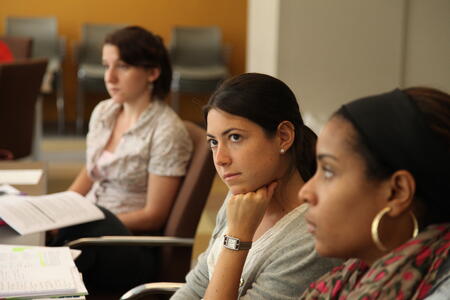
The frameworks that power great interactions with children can be applied to relationships with our coworkers. In our webinar Staying In-Sync: Creating Positive Interactions Between Teachers, panelists Kate Cline, Professional Services Manager at Teachstone, and Deidre Harris, Educational Consultant at Team Agreements, led a lively discussion about how to foster healthy relationships among your staff. They identified a few key areas that make up the foundation of this work. Let’s get into it!
Start with a Parallel Process
If you are familiar with CLASS®, you probably already know that it focuses on a framework meant to support interactions that create better outcomes for children. However, we know that we need to do more than just talk the talk; we need to walk the walk. This means we should be applying the principles that guide our interactions with children to our interactions with adults. We refer to this as parallel process.
Parallel process tells us that we need to approach the adults in our programs the way we would approach children, and you can keep that at the forefront by using CLASS as the foundation for interactions at all levels.
Let’s look at an example using the CLASS dimension of Positive Climate. Teachers create stronger bonds with their students when they engage in social conversation. Well, the same applies to educators and leaders who work together in programs. You can build a stronger bond and sense of community among your program’s adults through social conversation. Just as relationship building efforts (the HOW) are important because they impact children’s motivation to learn (the WHY), we see this pay off for educators who become more motivated in their work and collaboration when they are connected to one another.
So how does this look? It may mean allowing yourself or your staff more time in the day to interact with one another, whether that’s in the teacher’s lounge or simple chit chat on the playground. But it doesn’t stop there: imagine what this would look like across every CLASS domain. You can do this with your team by writing a team agreement.
Getting on the Same Page with a Team Agreement
Do you and your team members share the same vision for the program's goals? It may be time to check in and get on the same page by writing a team agreement. A team agreement gives each person involved the ability and opportunity to choose, change and challenge. But instead of agreements being applied by outside forces, good agreements should come from within the team. This creates trust (Positive Climate) and buy-in (Regard for Student Perspective), much like you’d want in a classroom. Here are a few key steps to building an agreement with your team.
- Start by Creating a Shared Vision
Your group needs to share a vision for your program. You may want to start by back mapping: as a group, imagine what the perfect day looks like and what has to happen between adults for this vision to come true. This can be done visually on a vision board or as a written post; just make sure the team has clarity in where it is going and what the team is trying to accomplish.
Keep in mind that there are many parts of a day, and each one can impact the team’s vision. Consider what areas of your routine have the greatest impact and start there. Deidre has resources to help prioritize those areas of impact here. - Determine the expectations for your team
One of the best ways to develop trust in a team is to be on the same page about how members are going to interact with each other. So what are the expectations for each team member? This could be where you run into some difficulty writing your agreement, as people tend to add personal preferences. Sticking to best practices helps produce the best outcome while not being personal–no one person is the bad guy if things go awry; the team can simply fall back to those good habits. - Establish Mutual Accountability
The last part of a team agreement is shared or mutual accountability. Many agreements fail because they simply aren’t written down. It doesn't matter how it's written as long it is documented in a way that the team can go back and refer to.
Need some inspiration for writing your team agreement? Deidre has templates available for your team to use available for free here.
Sticky Situations Will Arise
Even strong teams will run into sticky situations. You might not always be on the same page as one of your coworkers. This is when having a shared vision and team agreement can be especially helpful. Remember what your team has agreed upon–both in terms of vision and personal expectations. You may need to remind yourself or your coworker of the agreement your team made and encourage them in getting back on track and offer support as needed.
There Is a Community Ready to Support You
Whether your staff needs support in developing a team agreement or you have found yourself in a situation with a coworker that needs a little inspiration, there is a community ready to support you. The CLASS Learning Community is an online group of educators ready to weigh in and offer support. Check it out here!
